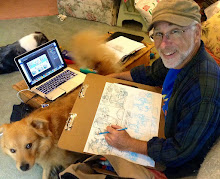A comment in my post "Comics Not Comics" about texture (Hi Vollsticks!) -and asking to see some examples of some of the pastel work done in my comic "fandancer" offer a good opportunity to compare some sketches--done in markers---and the finals, done in pastel--to illustrate the difference texture brings to tone and mood, certainly in fandancer-and in comics in general.
Texture was something that was built into my "vision" for FD right from the start--I knew I wanted color, I knew I wanted color built into the image creation rather than layered on top of line drawings--and I knew I wanted to evoke ben day textures(the texture of print) without resorting to photoshop and without arousing the aura of nostalgia that faux-ben day often brings with it. And so--pastel was my medium of choice.
I prefer not to blend or smudge--but lay color down one layer at a time, add fixative, add another layer-more fix, another layer, etc.-to build depth into the color, to allow the surface of the paper to work on the image, and to keep process front and center. Process is as important to me as the image is.
I don't think those qualities are very apparent in these lo-res digital images, but I think they are very clear in the book itself.
and of course, here's a couple of "nautical" examples from one of my favorite cartoonists-Roy Crane.
The first, in pen and ink, from his classic "Wash Tubbs & Cap'n Easy"-and the second from "Buz Sawyer", highlighting Sawyer's absolute mastery of the now lost art of zip-a-tone.
(& correct me if I'm wrong--I believe Sawyer used "Craftint" paper-wherein the gray tonalities were actually built into the paper and revealed as the artist applied a developer to the area he or she wanted to shade.)
Sawyer's use of gray tones was an ingenious response to the technology of his day, his textures worked in terms of representation--describing space, light and shade, volume, mood, etc--while subtly cluing the audience into process-and the nature of the medium in print-as well.
& just in case you weren't aware--there are some wonderful collections of Roy Crane's
work out now--Fantagraphics is reprinting the "Cap'n Easy"Sundays, and as well as Buz Sawyer .















